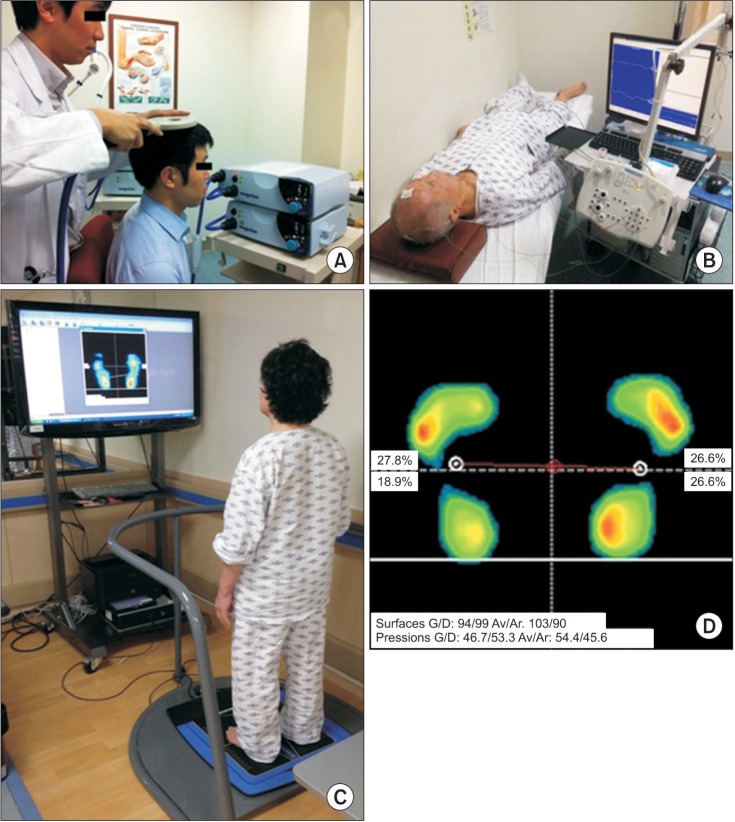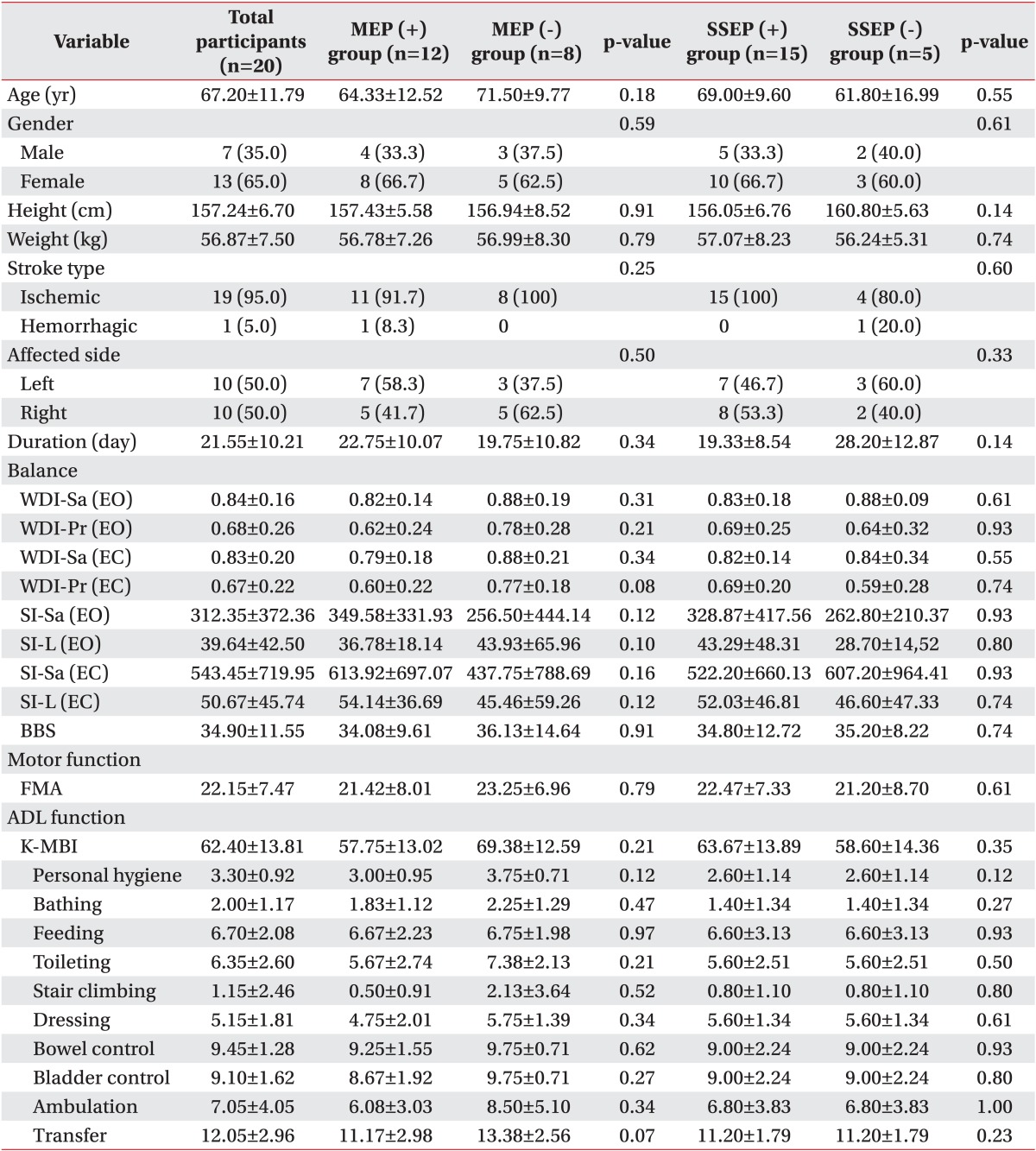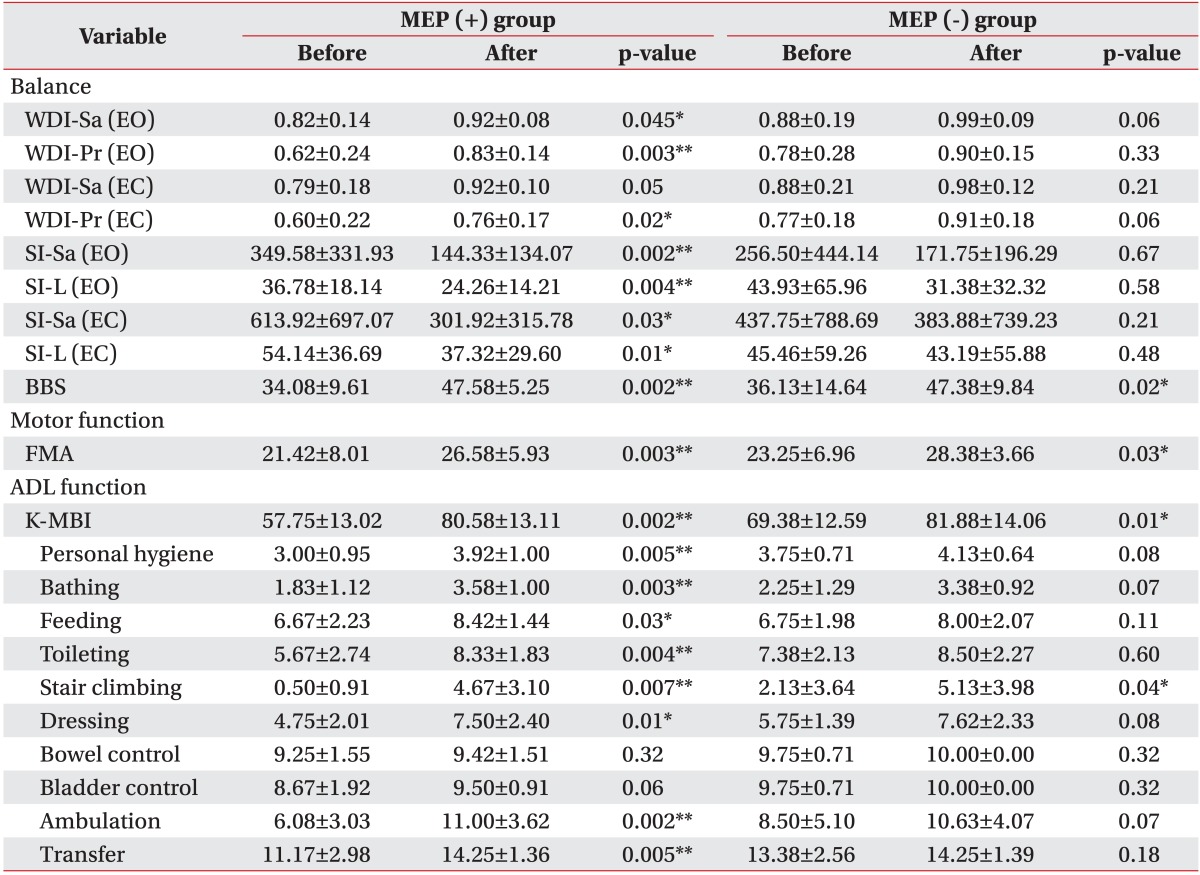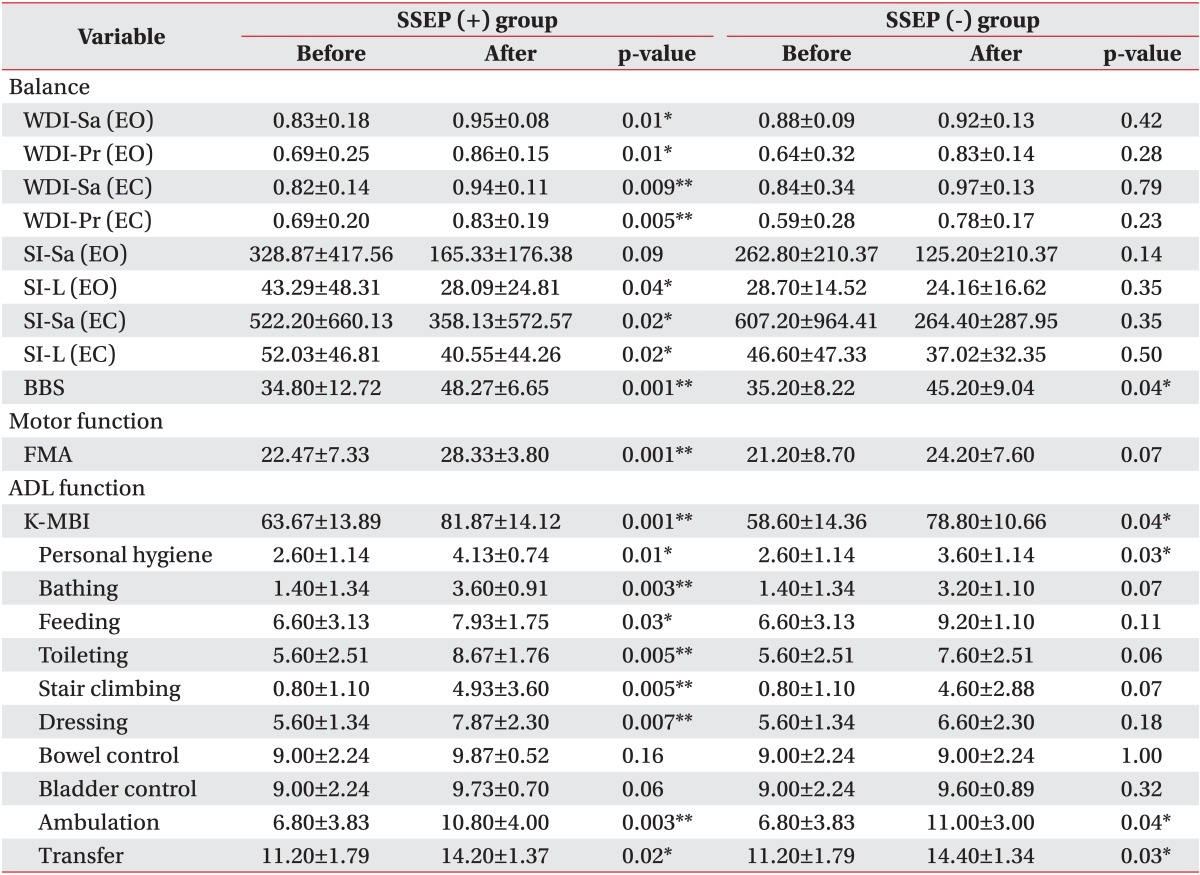1. Gresham GE, Fitzpatrick TE, Wolf PA, McNamara PM, Kannel WB, Dawber TR. Residual disability in survivors of stroke: the Framingham study. N Engl J Med. 1975; 293:954–956. PMID:
1178004.
2. Wolfe CD. The impact of stroke. Br Med Bull. 2000; 56:275–286. PMID:
11092079.

3. Hendricks HT, Pasman JW, van Limbeek J, Zwarts MJ. Motor evoked potentials of the lower extremity in predicting motor recovery and ambulation after stroke: a cohort study. Arch Phys Med Rehabil. 2003; 84:1373–1379. PMID:
13680577.
4. Kim HM, Chun MH, Kim CR, Park JY. Effects of dynamic ankle-foot orthosis on postural balance control in hemiparetic patients. J Korean Acad Rehabil Med. 2011; 35:188–194.
5. Olaogun MO, Lamidi RE, Obembe AO. Balance confidence and standing balance performance among stroke survivors with hemiparesis. J Med Med Sci. 2011; 2:750–757.
6. Laufer Y, Sivan D, Schwarzmann R, Sprecher E. Standing balance and functional recovery of patients with right and left hemiparesis in the early stages of rehabilitation. Neurorehabil Neural Repair. 2003; 17:207–213. PMID:
14677216.

7. Al-Rawi MA, Hamdan FB, Abdul-Muttalib AK. Somatosensory evoked potentials as a predictor for functional recovery of the upper limb in patients with stroke. J Stroke Cerebrovasc Dis. 2009; 18:262–268. PMID:
19560679.

8. Shumway-Cook A, Anson D, Haller S. Postural sway biofeedback: its effect on reestablishing stance stability in hemiplegic patients. Arch Phys Med Rehabil. 1988; 69:395–400. PMID:
3377664.
9. Laufer Y, Dickstein R, Resnik S, Marcovitz E. Weight-bearing shifts of hemiparetic and healthy adults upon stepping on stairs of various heights. Clin Rehabil. 2000; 14:125–129. PMID:
10763788.

10. Ahmed R, Zuberi BF, Afsar S. Stroke scale score and early prediction of outcome after stroke. J Coll Physicians Surg Pak. 2004; 14:267–269. PMID:
15225452.
11. Jongbloed L. Prediction of function after stroke: a critical review. Stroke. 1986; 17:765–776. PMID:
3526649.

12. Feys H, van Hees J, Bruyninckx F, Mercelis R, de Weerdt W. Value of somatosensory and motor evoked potentials in predicting arm recovery after a stroke. J Neurol Neurosurg Psychiatry. 2000; 68:323–331. PMID:
10675214.

13. Nascimbeni A, Gaffuri A, Imazio P. Motor evoked potentials: prognostic value in motor recovery after stroke. Funct Neurol. 2006; 21:199–203. PMID:
17367579.
14. Bembenek JP, Kurczych K, Karli Nski M, Czlonkowska A. The prognostic value of motor-evoked potentials in motor recovery and functional outcome after stroke: a systematic review of the literature. Funct Neurol. 2012; 27:79–84. PMID:
23158578.
15. Pizzi A, Carrai R, Falsini C, Martini M, Verdesca S, Grippo A. Prognostic value of motor evoked potentials in motor function recovery of upper limb after stroke. J Rehabil Med. 2009; 41:654–660. PMID:
19565160.

16. Lim KB, Kim JA. Activity of daily living and motor evoked potentials in the subacute stroke patients. Ann Rehabil Med. 2013; 37:82–87. PMID:
23525518.

17. Escudero JV, Sancho J, Bautista D, Escudero M, Lopez-Trigo J. Prognostic value of motor evoked potential obtained by transcranial magnetic brain stimulation in motor function recovery in patients with acute ischemic stroke. Stroke. 1998; 29:1854–1859. PMID:
9731608.

18. Son SY, Park SH, Seo JH, Ko MH. Correlation of the motor evoked potentials amplitude and hand function of the affected side in stroke. J Korean Acad Rehabil Med. 2011; 35:34–41.
19. Hendricks HT, Zwarts MJ, Plat EF, van Limbeek J. Systematic review for the early prediction of motor and functional outcome after stroke by using motor-evoked potentials. Arch Phys Med Rehabil. 2002; 83:1303–1308. PMID:
12235613.

20. Seo YB, Lee JK, Shin DJ, Lee YB. Prediction of clinical outcomes in patients with acute ischemic stroke by measurements of motor evoked potentials. Korean J Cerebrovasc Surg. 2009; 11:154–160.
21. Dickstein R, Zaslanski R, Heffes Y, Mizrachi E, Shabtai EL, Abulaffio N. Somatosensory evoked potentials of the posterior tibial nerve in hemiparetic patients: relation to stance balance and walking ability. Arch Phys Med Rehabil. 1997; 78:1125–1128. PMID:
9339164.

22. Conforto AB, Ferreiro KN, Tomasi C, dos Santos RL, Moreira VL, Marie SK, et al. Effects of somatosensory stimulation on motor function after subacute stroke. Neurorehabil Neural Repair. 2010; 24:263–272. PMID:
19884642.

23. Tzvetanov P, Rousseff RT, Milanov I. Lower limb SSEP changes in stroke-predictive values regarding functional recovery. Clin Neurol Neurosurg. 2003; 105:121–127. PMID:
12691805.

24. Tzvetanov P, Rousseff RT, Atanassova P. Prognostic value of median and tibial somatosensory evoked potentials in acute stroke. Neurosci Lett. 2005; 380:99–104. PMID:
15854759.

25. Kwon HK, Yim SK, Kim L, Chae SH, Lee HJ. Clinical usefulness of somatosensory evoked potentials in patients with stroke. J Korean Acad Rehabil Med. 2003; 27:355–360.
26. Keren O, Ring H, Solzi P, Pratt H, Groswasser Z. Upper limb somatosensory evoked potentials as a predictor of rehabilitation progress in dominant hemisphere stroke patients. Stroke. 1993; 24:1789–1793. PMID:
8248956.

27. Kim SW, Kim SB, Lee SY, Koh SE, Lee JM, Lee JY. Motor evoked potentials and somatosensory evoked potentials of upper and lower extremities for prediction of functional recovery in stroke. Brain Neurorehabil. 2012; 5:24–31.

28. Lee SY, Lim JY, Kang EK, Han MK, Bae HJ, Paik NJ. Prediction of good functional recovery after stroke based on combined motor and somatosensory evoked potential findings. J Rehabil Med. 2010; 42:16–20. PMID:
20111839.

29. Pereon Y, Aubertin P, Guiheneuc P. Prognostic significance of electrophysiological investigations in stroke patients: somatosensory and motor evoked potentials and sympathetic skin response. Neurophysiol Clin. 1995; 25:146–157. PMID:
8524209.
30. Lee JJ, Jung HY. The correlation of hemiplegic upper limb recovery with SEP and MEP in subjects with a stroke. J Korean Acad Rehabil Med. 2008; 32:512–517.
31. Rossini PM, Barker AT, Berardelli A, Caramia MD, Caruso G, Cracco RQ, et al. Non-invasive electrical and magnetic stimulation of the brain, spinal cord and roots: basic principles and procedures for routine clinical application: report of an IFCN committee. Electroencephalogr Clin Neurophysiol. 1994; 91:79–92. PMID:
7519144.

32. Rossini PM, Narici L, Martino G, Pasquarelli A, Peresson M, Pizzella V, et al. Analysis of interhemispheric asymmetries of somatosensory evoked magnetic fields to right and left median nerve stimulation. Electroencephalogr Clin Neurophysiol. 1994; 91:476–482. PMID:
7529686.

33. Blum L, Korner-Bitensky N. Usefulness of the Berg Balance Scale in stroke rehabilitation: a systematic review. Phys Ther. 2008; 88:559–566. PMID:
18292215.

34. Jung HY, Park JH, Shim JJ, Kim MJ, Hwang MR, Kim SH. Reliability test of Korean version of Berg Balance Scale. J Korean Acad Rehabil Med. 2006; 30:611–618.
35. Jung HY, Park BK, Shin HS, Kang YK, Pyun SB, Paik NJ, et al. Development of the Korean version of Modified Barthel Index (K-MBI): multi-center study for subjects with stroke. J Korean Acad Rehabil Med. 2007; 31:283–297.
36. Park DJ, Congdon NG. Evidence for an "epidemic" of myopia. Ann Acad Med Singapore. 2004; 33:21–26. PMID:
15008557.









 PDF
PDF ePub
ePub Citation
Citation Print
Print


 XML Download
XML Download